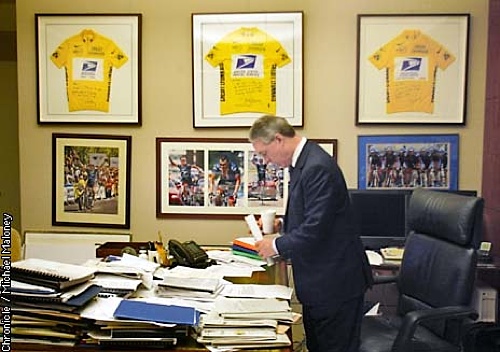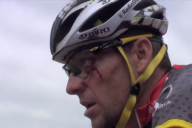The evolution of funding in cycling from the traditional trade-team format that was prevalent in the sport prior to the mid 1980s to its current sponsor-style format (brought to the forefront by the La Vie Claire team founded by French industrialist Bernard Tapie) ushered in a new era of sponsorship and funding to the sport. Corporations based in the U.S that were formerly uninvolved began to turn their attentions to the previously-unexplored opportunities in cycling, recognizing the efforts of businessmen like Tapie and also noting the marketing savvy of then-UCI President Hein Verbruggen.
Likewise, there has been an evolution in the organization of professional cycling events in the United States – from the Coors Classic in the 70s and 80s to the Tour DuPont in the 90s, both of which faded away due to sponsorship challenges in their respective eras. This void was soon to be filled by the emergence of a stage race on the West Coast, aided by corporations based in the state of California, signalling a shift from Colorado and the East Coast to a newly created center of cycling activity.
There are three companies that have become synonymous with the Tour of California: Amgen, the title sponsor; AEG, the owner of the event; Montgomery Securities, the company behind Tailwind Sports that gave Lance Armstrong his chance to come back to cycling. These three companies also have history of connection outside of cycling that dates back to the 1980s. The unfortunate by-product of their joint involvement has been scandals that have circled cycling since Armstrong’s first Tour win. One company in particular has emerged to become an indirect influential force in the globalization of cycling.
In 1983 a small biotech firm by the name of Amgen was in the midst of taking their company public with a risky IPO in a financial climate hostile to the biotechnology field. As noted in her book, From Alchemy to IPO, author Cynthia Robbins-Roth noted the difficulties Amgen had in raising funds. Magically undeterred by this difficult environment, Amgen co-founder George Rathmann somehow managed to secure $43 million for their IPO that was underwritten by three investment firms. Two of these firms were the well-established companies Smith Barney and Dean Witter.
The third company was a relatively new creation, founded in San Francisco in 1978 with only a five-year track history prior to helping underwrite the Amgen IPO. Called Montgomery Securities, it was founded by a dynamic man by the name of Thomas Weisel who had developed a strong group of contacts in the San Francisco area. Weisel had joined the firm in 1971 back when it was known as Robertson, Colman, and Siebel. He later led a mutiny at the firm which led to the departure of Robertson and Colman in 1978. A bitter rivalry ensued between Robertson and Weisel after this episode, one which continues to this day. It is also interesting to note that Weisel’s formal involvement with cycling began with Montgomery Securities’ sponsorship of Eddie Borysewicz and his cycling team, called Montgomery-Subaru, in 1989. In its second year of operation, the team welcomed one Lance Armstrong into its ranks.

Weisel's office reflected his affinity for cycling and for Armstrong (photo Chronicle/Michael Maloney)
Amgen has a long interconnected involvement with cycling. Beyond the sponsorship of the Tour of California, the Amgen product Epogen had been credited by Lance Armstrong as saving his life during his cancer treatment in the late 90s. The history of Epogen has been one filled with question marks involving the potential use of those specific products by the PDM team in 1990 that led to several high-profile deaths. Could the alleged experimental use of Epogen by cycling teams in the late 80s and early 90s be interpreted as a “field study” of the drug and its applications? The former doctor of the PDM team, Wim Sanders, had been investigated in the Netherlands in the late 1990s, and the name of both the company and its product surfaced during that investigation, which indicates the answer to the question could be yes.
Edmund R. Burke, who had ties to the blood-transfusion debacle in the 1984 Olympics and received sanctions for his part in the transfusing of American athletes at those Olympics, noted the impact of EPO on professional cycling. In his book entitled Dope: A History of Performance Enhancement in Sports from the Nineteeth Century to Today, Daniel M. Rosen discusses Burke’s conclusions that EPO held enormous benefits for cyclists, however if used improperly, it could kill. Amgen was seeking approval of Epogen in Europe in 1990 and the coincidence of cycling deaths related to heart failure – a major side effect of improper Epogen usage – is impossible to ignore. It should also be noted that Burke had a close relationship with “Eddie B,” the aforementioned directeur sportif for Weisel’s first cycling team incarnation, Montgomery-Subaru, which later evolved into the US Postal Service cycling team in the mid 90s. Burke passed away in 2002 due to heart failure during exercise.
Amgen has been the focus of criticisms over the years, with one chief critic being Merrill Goozner, who in 2006 wrote “The Amgen Rip-Off” where he cited the expenditure of Medicare on the Epogen drug far exceeded any other drug expenditure by the organization. The same article noted the decrease in life span of the individuals who used the product, and the increased incidence of cancer occuring in those who used the drug to help raise their hematocrit levels while on kidney dialysis. Amgen also faced criticism of their product’s benefits in an article entitled, “Pharmaceutical Erythropoietin Use in Patients With Cancer: Is It Time to Abandon Ship or Just Drop Anchor?” by Ayalew Tefferi. Tefferi questions the validity of the use of Epogen, and noted that one study on the drug was abandoned:
The study was terminated early because of a significantly worse 12-month survival rate in Epo-treated patients who displayed increased rates of disease progression and thrombotic and vascular events.
In addition to backing Amgen, Weisel’s Montgomery Securities had financial relationships with other firms in the biotechnology sector, including 5am Ventures, the company that in 2002 brought together as its managing partners Andrew Schwab, a former VP at Montgomery Securities, and Scott Rocklage, a former CEO of Nycomed Salutar. This interesting connection has significance to cycling, as the US Postal team was revealed by French journalists to be using Actovegin, a Nycomed product, when US Postal employees carelessly dumped trash during the 2000 Tour de France.
While some might say that these relationships could merely have been passing fancy or coincidental contact, the significance of the relationship between Amgen and those involved with Montgomery Securities is still felt today. Lewis Coleman, a former executive at Montgomery Securities, sits on the Board of Directors with current Amgen CEO Kevin Sharer at the well-known aerospace/shipbuilding/electronics firm Northrop Grumman. And 5am Ventures is still active to this day with former Montegomery Securities employees operating within the company structure.
Based on this information, the sport of cycling could be construed as a leading edge of biotechnology experimentation. No other sport in the world demands of its athletes the same sort of sustained physical exertion over a 12-month period. And with its unique characteristic of athletes pushing their bodies to the very limits of physical ability for extended periods of time, the peloton has been the perfect petrie dish for field testing all sorts of biotech products under the guise of performance-enhancement. From caffeine to cocaine, amphetamines to cryotherapy, cycling has been a testing ground for biotech and drug companies since before World War II.
There was a side bonus to the Weisel-driven Postal bus, and that was the fact that Armstrong’s star factor opened doors for not only Weisel, but also for Weisel’s various companies to network with an ever-expanding sphere of influence. Reed Albergotti and Vanessa O’Connell chronicled this phenomenon in their article for the Wall Street Journal on December 18th, 2010, entitled “For Cycling’s Big Backers, Joy Ride Ends in Grief.” In it, they noted the fact that US Postal was a money-losing venture surrounded by the doping cloud of suspicion. But many powerful people in American industry enjoyed the fact that they could rub shoulders with Lance Armstrong and ride alongside him at various charity and PR events, something that wasn’t possible in other sports, like baseball spring training, for example.
However, the benefits for the biotechnology field, if the suppositions are to be believed, far outweighed the losses associated specifically with the “money losing venture” of the US Postal Cycling Team. To this day, Amgen touts the endorsement of Lance Armstrong and the use of Epogen in his cancer treatment. The backers of the US Postal team, however, chose to view the bigger picture beyond the monetary losses associated with the team as a new component to the equation was introduced.
In 2002, Mike Plant, then head of USA Cycling, brought Hein Verbruggen, then president of the UCI, to meet a gentleman from Colorado who had an avid interest in cycling. That man was Philip Anschutz, billionaire backer of mega-deals involving American firms such as Qwest Communications, and founder a sports entertainment empire with the purchase of the Los Angeles Kings hockey team. In 1995 Anschutz had established his company, AEG, and soon became involved with entertainment facility management, concert promotion and sports promotion.
Anschutz had an impressive track record of seeing the bigger picture and identifying business opportunities. He had a deep appreciation for cycling, and with his corporation, AEG, developed the HomeDepot Center on the campus of California State University where the 2005 UCI World Track Championships were held. Anschutz recognized the value of Lance Armstong’s impact on cycling, and leveraged that popularity with the assistance of Mike Plant (currently a UCI Management Committee member) to meet with Verbruggen to pitch the idea of the Tour of California, to commence in 2006, the year after the track championships.
So how was it that Amgen became a title sponsor of a race established by Anschutz’s AEG corporation with the help of Plant and the approval of Verbruggen? Beyond the yearbook answers given by various people involved with the starting of the race, there is always the interesting back story that is revealed by examining the board of director appointments of the corporations involved. The name that seems to consistently appear, connecting the three companies directly, is that of Lewis Coleman.
Coleman was a former senior managing director at Montgomery Securities. He was also appointed to the board of directors of Regal Entertainment Group, which is owned by Philip Anschutz. Coleman currently sits on the board of directors of Northrop Grumman with the current CEO of Amgen, Kevin Sharer. The appointments do not occur for random reasons, and certainly demonstrates the close ties between all three companies.
Coleman seems to be the common link that ties the relationship between Anschutz, Amgen, and Montgomery Securities –three companies that have provided the financial backing for the sport of cycling to accelerate into the public’s consciousness via the mighty feat of Armstrong’s unprecedented seven Tour de France victories.
The question remains – What course will American cycling ultimately take? – as Amgen’s involvement in cycling beyond the Tour of California title sponsorship and their cancer charity has not increased since their initial stake in 2006, and Thomas Weisel has ridden off into the semi-retirement sunset following the purchase of his current company, Thomas Weisel Partners, by Stifel Financial.
It would seem that of the three corporations involved with cycling’s evolution through the late 90s and early in the new millennium, AEG has taken their impact beyond the shores of the United States, managing facilities in Muscat, Qatar, and throughout Australia. In fact, AEG announced in 2011 a partnership with companies in China to manage a facility in Shanghai, and their crowning achievement in Beijing with the former Olympic basketball venue that became the first Chinese venue to issue naming rights, which went to Mastercard. The Beijing venue also has developed a working arrangement with NBA International, managed by Heidi Ueberroth, daughter of Peter Ueberroth, the man behind the 1984 Los Angeles Olympics. What remains to be seen is if AEG will continue their commitment to develop cycling on the shores of the United States, or if their founder’s meeting with Verbruggen and Plant began their emergence as a world player in the sports entertainment field at the expense of the US cycling community.
What can be concluded, though, is the fact that without the efforts of Amgen, AEG, and Montgomery Securities, U.S. cycling would not have influenced the sport on a global level from 1999 to 2006. The efforts of these three raised the sport’s profile in the United States to the mainstream and helped it evolve from the nascency that was American cycling during LeMond’s European successes.














3 Comments
Hat tip, Thacker. Very informative article.
EPO killed more than high profile riders. Under-23’s were dying of heart attacks. Way back in the pre-Internet days velonews would publish brief mentions of Euro riders dying of heart attacks and Hein’s response was polite indifference.
Velonews still bends over backwards to minimize any appearance of doping.
Thom Weisel has no end of dirty laundry, most of which has never been prosecuted.
Does anyone find it coincidental that Amgen holds the patent for Epogen, a brand of EPO?